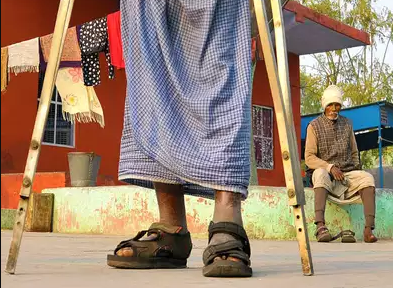By Debadurllav Harichandan, OP
Bhubaneswar, Feb 23: At a time when the Centre has set an ambitious target of eliminating leprosy from India – “Leprosy-Mukt Bharat” – by 2027, the disease is showing no sign of subsiding in Odisha which has recorded 8,396 cases in 2023-24 as compared to 6,148 in 2020-21. Making things worse, funding from the Union government has declined between 2022-23 and 2024-25, thereby making the fight against the chronic bacterial disease weaker.
According to reports, National Leprosy Eradication Programme (NLEP), under the Ministry of Health and Family Welfare (MoHFW), has set an ambitious goal of achieving Leprosy-Mukt Bharat by 2027. However, Odisha has been reporting a prevalence rate (PR) of more than 1 case per 10,000 people for the last five years. In western Odisha, the crisis is even worse, with some districts consistently logging PR of 3 to 5 per 10,000.
Year-wise leprosy cases in Odisha reflect an alarming trend. While in 2020-21, the state reported 6,148 cases, the figures saw a minor dip to 5,729 in 2021-22. But it again surged to 7,197 in 2022-23, and 8,396 in 2023-24. Recorded cases till December 2024 stood at 6,194. Experts, however, are of the view that the entire-year’s figures (2024-25) would surpass the records of previous years.
Apart from public health concerns, Odisha’s rising leprosy burden is an economic risk. The state’s female labour force participation rate (LFPR) stands at 49.4 per cent—above the national average of 42 per cent. With women comprising 41.6 per cent of leprosy cases in 2023-24, the highest ever; this may potentially disrupt the economic activity in the state. Since the industries, services, and informal labour sectors are dependent on participation of female workers, the surge may impact the workforce productivity, the experts added.
Meanwhile, Odisha continues to be an exception in India’s fight against leprosy. According to NLEP data, nearly 90 per cent of districts across 28 states have achieved zero-case status, but over two-third of Odisha districts are yet to achieve this.
A family’s battle with leprosy
Sajani Mohanty, 67, an inmate at Ramakrushna Leprosy Colony near Kharvel Nagar here, narrated how the disease shattered the happiness of her family. Recalling her childhood days, Sajani said her parents abandoned her at Berhampur bus station upon discovering her condition when she was barely five. Later, a childless Brahmin couple embraced her, but this too was short-lived.
“One day, they asked me to clean a fish. But the bones got stuck in my hands, and I didn’t even feel them because of nerve damage. That’s when they realised I had leprosy. Soon after, I was abandoned,” she revealed, showing the bruises and burnt wounds, scattered all over her claw hands- an apparent sign of her encounters with hot objects, which she could not feel due to lack of nerve sensation.
She was then moved to a shelter home where she met her husband- another leprosy victim. Later, the couple shifted to Capital City, with fresh hopes for a new beginning.
Her husband Narayan Mohanty then worked as a daily wager near Bhima Tangi area. While normalcy made a comeback in the couple’s life, one fine day, Narayan complained of intense chest pain following a strenuous physical activity.
“We had no money for treatment, so we took him to a local community health centre. But within a few days, we ran out of cash. I was forced to beg on the streets to make ends meet for my family. He died a few months later,” she said, while controlling her tears, and recalled how she and her children survived on torani (rice water) for several months.
Sajani’s daughter, Sanghamitra Mohanty, mother of an eight-year-old, said she dropped out of graduation due to financial constraints. “I have enrolled myself in a distance learning programme, and I hope I will complete my graduation this time,” she added.
State apathy & drug crunch
A senior district public health officer, requesting anonymity, said the state administration has turned a blind eye to the rising leprosy cases. “I have raised concerns at several meetings about the acute shortage of Rifampicin, a drug for leprosy, but the health secretary is all words, and no action. Meetings end with assurances only,” he said.
As per government norms, a chief district medical officer (CDMO) can issue urgent tenders for immediate procurement of medicines. However, the official claimed, there have been no serious bidders, leaving leprosy patients without access to life-saving drugs.
“If cases don’t decline soon, I won’t be surprised if the Union Government increases the PR benchmark to 1 case per 20,000 to make the crisis look less severe,” he remarked.
Fund cut amid rising cases
This is a matter of grave concern, that when the state is registering a rise in cases, fund from the Centre under NLEP has been declining. Such rapid reduction in funds has weakened Odisha’s fight against leprosy, even when it remained in the list of top five states in India, with the highest number of leprosy cases.
PNN
